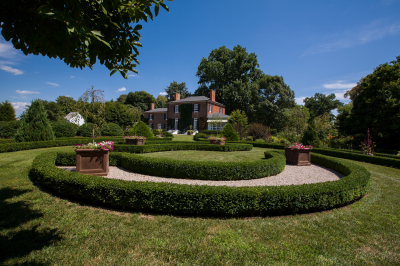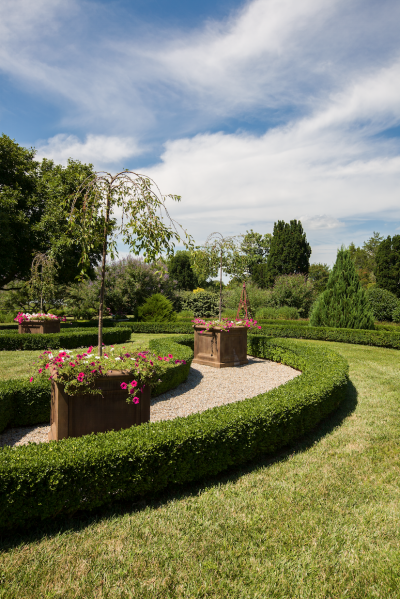- © 2025 Annapolis Home Magazine
- All Rights Reserved
By Kymberly Taylor | Photography by Geoffrey Hodgdon

What does a nineteenth-century garden have to do with a sports car from the 1930s? Both are the rare progeny of a private world, a past seldom penetrated by outsiders. These worlds will merge briefly the last weekend in September, when participants of the Eighth Annual St. Michaels Concours d’Elegance will stroll the rolling grounds of the Knightly Estate for a private party.
During the era of big bands, Gone With the Wind, and Charlie Chaplin, you would certainly see a car like the one parked here, a 1936 Bugatti Type 57 Atlantic Coup, at all the grand parties. The Bugatti is one of the world’s rarest and most expensive cars. There were four Bugatti Type 57 Atlantic Coupes produced. Three survive. There are two exact recreations made with all Bugatti parts. Jay Leno has one and the other is pictured here from the North Collection.

Over the past twenty years, the North family has painstakingly recreated this car using Bugatti parts, right down to the fenders, instrument panel, and engine drive train. It is identical to the Bugatti Atlantic owned by Ralph Lauren. Etorre Bugatti’s, son, Jean Bugatti, personally designed the Atlantic and was influenced heavily by 1930’s aircraft design. He combined the sleek aerodynamic lines of the fighter jet with the teardrop shape, which was avant garde at the time. Other features are a raised dorsal fin and v-shaped dip at the bottom of the radiator and mesh grilles on either side of the engine compartment.

Upon examination, the Knightly Estate, composed of a towering Federal-style home from the 1820s and a seventy-acre farm, is equally impressive. Its owner, Alice Ryan, is a native of Talbot County and founder of the nonprofit Women and Girls Fund of the Mid-Shore as well as Chair of the Board for the rape crisis and support center For All Seasons. In 2007, she and her husband called in Hans Bleinberger, a horticulturist at McHale Landscape Design in Annapolis, to simply repair the fountain, and revive the plants. “What followed were plantings, and then more plantings,” he recalls. For the next seven years, Bleinberger worked with the faint imprint of what may have been a Victorian garden conceived in the 1800s. He took the Victorian garden to its next incarnation, the Edwardian garden. “The Edwardian garden plan made sense, as it is a modern adaptation of a traditional form,” he explains.

The Edwardian style garden, whose heyday was in England from about 1900 to 1906, evolved from the highly structured Victorian garden, which has precise, geometric lines and organized groups of plantings. In contrast, the Edwardian garden incorporates curving paths and is meant to be strolled through and examined, providing entertainment to gentility. Ryan’s garden retains the formal border but flowers inside are allowed to spill forth, explains Bleinberger. “Alice added her own special touch,” he recalls. Taking advantage of the freedom afforded her by the twenty-first century, she expressed her individuality, planting hundreds of bulbs that explode with color, yet still respect the Edwardian form.
Paths create order and control circulation, explains Bleinberger. Ryan diverted once again, and created for herself a tiny enclave where “offerings” from nature have taken root and thrived. “I like Leeds Creek. I grew up two farms down, and I have lots of good memories,” she says. Here, below a grassy knoll, is a bench painted sky blue, a gnome, and azaleas planted in memory of her father. “This is my sense of whimsy,” she says. “I love this spot. See that watermelon over there? It must have sprung up when the mulch was put down. I just had to leave it.”
Most likely, she will work right up until the day this Bugatti reappears in her gardens. Ryan is hosting a party for contest participants. A day before the Concours d’Elegance officially opens to the public, it is a tradition for the show cars to form a line and promenade through Cambridge to St. Michaels, dropping in for refreshments at a neighborhood estate along the way.
 George M. Walish, Jr., chairman and founder of the St. Michaels Concours, notes that the Concours has expanded and that this year’s entries include more prizewinning vehicles seen at hot spots such as Amelia Island and Pebble Beach. Some of the rare automobiles on display include a 1934 Pierce-Arrow convertible sedan with coachwork by LeBaron, the only one made; a 1932 Packard Model 904 convertible Victoria with coachwork by Dietrich, one of four built; and a 1929 Rolls Royce P1 convertible sedan with coachwork by Hibbard & Darrin of Paris, originally owned by the Rothschild family. For sports car enthusiasts, the entrants include a 1949 Jaguar XK120 Roadster with alloy body, one of only twenty-five made; a 1954 Siata 200CS, body by Balbo; and a 1954 Arnolt-Bristol Bolide, body by Bertone.
George M. Walish, Jr., chairman and founder of the St. Michaels Concours, notes that the Concours has expanded and that this year’s entries include more prizewinning vehicles seen at hot spots such as Amelia Island and Pebble Beach. Some of the rare automobiles on display include a 1934 Pierce-Arrow convertible sedan with coachwork by LeBaron, the only one made; a 1932 Packard Model 904 convertible Victoria with coachwork by Dietrich, one of four built; and a 1929 Rolls Royce P1 convertible sedan with coachwork by Hibbard & Darrin of Paris, originally owned by the Rothschild family. For sports car enthusiasts, the entrants include a 1949 Jaguar XK120 Roadster with alloy body, one of only twenty-five made; a 1954 Siata 200CS, body by Balbo; and a 1954 Arnolt-Bristol Bolide, body by Bertone.
Also, there will be a fashion show, with a catwalk. Walish explains that the origin of the Concours d’Elegance (Competition of Excellence) dates back to the 1920s and 1930s in the Parc de Paris. The coutures would introduce the latest in fashion and the automobile coach builders would display the latest in automotive design. He continues this tradition and promises us that the collision between the worlds of antique cars and contemporary fashion will produce an exceptionally good time.
2014 St. Michaels Concours d’Elegance
SUNDAY, SEPTEMBER 28, 2014
10:00 AM TO 4:00 PM
For event details, go to www.smcde.org
From Vol. 5, No. 5 2014
Annapolis Home Magazine